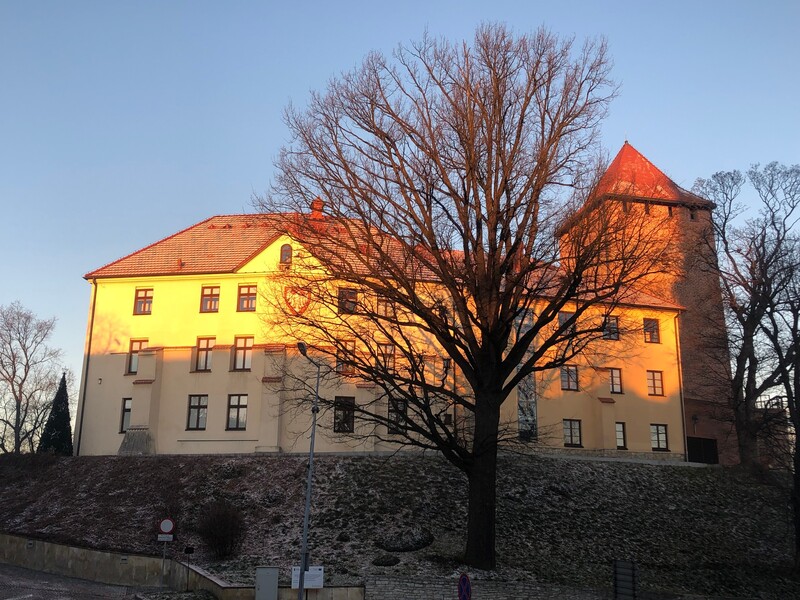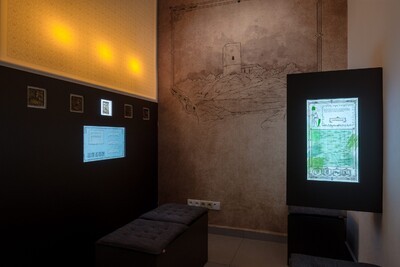In 1863, the great fire of the city of Oświęcim ravaged the old city hall, probably dating back to the 16th century, which was located in the central part of the market square. In 1873, the land for the construction of a new magistrate was purchased from Anna Kowalska. The works carried out between 1874-75 were initially supervised by the Oświęcim builder Leopold Michl, and then they were continued by the expert from Biała, Emanuel Rost. In September 1875 it was noted that engineer Emanuel Rost “… has already finished all the internal walls, vaults and staircases of that building, a further advance payment of PLN 2,000 to the account of this building shall be made in accordance with the settlement …’. Unfortunately, the architectural design was not preserved, nor was it possible to establish the name of its author. On 1 November 1875, the seat of the Oświęcim magistrate was moved to a new building, but the finishing works were still in progress. In 1876, a clock from the C. Weiss company in Głogów was installed on the facade of the building.
The City Hall was used until the outbreak of World War II. The German occupation authorities incorporated it into the system protecting the city centre against artillery attacks by connecting it through an underground corridor with a bunker located in the central part of the market square, at the site of the oldest city hall, whose relics were revealed in 2012. In the post-war period, the building taken over by the communist authorities was the seat of the Poviat UBP [Department of Public Security] in Biała, and then, until the 1970s the Civic Militia headquarters and the Military Draft Office were located here. In the following years, the “city hall” building housed the residents: the Society of Lovers of the Land of Oświęcim, the Council of the Old Town Estate and the “Oświęcim Old Town” Club.
The historic nineteenth-century building of the former city hall, where the mayor Roman Mayzel served from 1909 to 1935, was renovated and given over to the exhibition functions of the Castle Museum in Oświęcim. Since July 2018, the permanent exhibition “In the space of history. History of the City of Oświęcim” has been presented here.
| Day of the week | Opening hours | ||
|---|---|---|---|
| Tuesday | 10:00 - 16:00 | ||
| Wednesday | 10:00 - 16:00 | ||
| Thursday | 10:00 - 16:00 | ||
| Friday | 10:00 - 15:00 | ||
| Sunday | 10:00 - 16:00 | ||
| Holidays | Opening hours |
|---|---|
| 2025.05.01 (Thursday) | x |
| 2025.05.03 (Saturday) | x |
| 2025.11.01 (Saturday) | x |
| 2025.11.11 (Tuesday) | x |
| 2025.12.25 (Thursday) | x |
| 2025.12.26 (Friday) | x |
| Day of the week | Opening hours | ||
|---|---|---|---|
| Tuesday | 10:00 - 18:00 | ||
| Wednesday | 10:00 - 18:00 | ||
| Thursday | 10:00 - 18:00 | ||
| Friday | 10:00 - 18:00 | ||
| Saturday | 10:00 - 18:00 | ||
| Sunday | 10:00 - 18:00 | ||
| Holidays | Opening hours |
|---|---|
| 2025.06.19 (Thursday) | x |
| 2025.08.15 (Friday) | x |
| Tickets | ||
|---|---|---|
| normal | 12.00 PLN | |
| reduced | 8.00 PLN | |
| family | 30.00 PLN | Do 5 os. w tym 1 lub 2 osoby dorosłe. |
| children free of charge up to the age of 7 |
| Guide | |
|---|---|
| in Polish for a fee | 150.00 PLN |
| when? | name | where? | about what? | for free | for children | |
|---|---|---|---|---|---|---|
 | The archaeological collection Permanent exhibition | The Castle Museum in Oświęcim ul. Zamkowa 1 32-600 Oświęcim Lesser Poland | yes | |||
 | W Królewskim Mieście Oświęcimiu Permanent exhibition | The Castle Museum in Oświęcim ul. Zamkowa 1 32-600 Oświęcim Lesser Poland | city | yes | ||
 | Wnętrza Mieszczańskie Permanent exhibition | The Castle Museum in Oświęcim ul. Zamkowa 1 32-600 Oświęcim Lesser Poland | interiors and everyday life | yes | ||
 | W przestrzeniach historii. Dzieje miasta Oświęcimia Permanent exhibition | Town Hall Rynek Główny 2 32-600 Oświęcim Lesser Poland | city | yes |